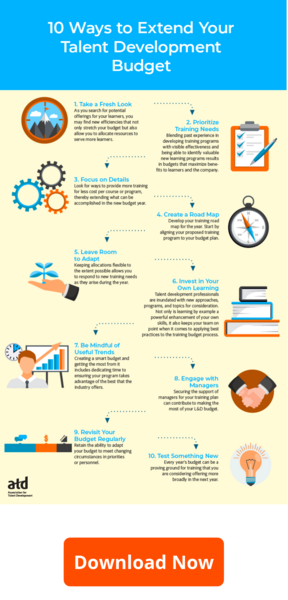ATD Blog
10 Ways to Extend Your L&D Budget
Wed Oct 03 2018

“Price is what you pay. Value is what you get.”
Price and value both drive learning and development budget decisions. Getting the best of each drives talent development professionals toward their own higher levels of achievement. Warren Buffett’s reminder is timely at this moment of the year when budgets are at the top of many to-do lists.

Here are 10 tips for making your L&D budget go further.
1. Take a fresh look.
A good place to start is to size up the training program and its accompanying budget for the year to date. How has your training plan worked out? An honest review of how programs were received by learners, evaluated by managers, and assessed by your training team provides insight that will inform your budget prep. In addition, as you search for potential offerings for your learners, you may find new efficiencies that not only stretch your budget but also allow you to allocate resources to serve more learners.
2. Prioritize training needs.
Companies and employees evolve. Addressing leadership initiatives, corporate goals, and learner requests are steps you can take to develop support for your budget. Meanwhile, continue emphasizing the value of your core training program that each year helps learners become more productive and engaged in their jobs. Blending past experience in developing training programs with visible effectiveness and the expertise to identify valuable new learning programs results in budgets that maximize benefits to learners and the company.
3. Focus on details.
Every line counts on a budget sheet. Look for ways to provide more training for less cost per course or program, thereby extending what can be accomplished in the new budget year. Is there a training method you haven’t explored, such as e-learning? Consider drawing up a table that compares training topics and content delivery methods. Include program cost but also supplemental expenses for travel and lodging. Evaluate facilitators presenting courses and workshops and seek out feedback from past attendees. The goal is to account for the price—and value—of each expenditure.
4. Create a road map.
A good next step is to develop your training road map for the year. Start by aligning your proposed training program to your budget plan. At this stage, nothing is set in stone. You’ve already determined company needs and can now match those with training topics. Is there a more efficient way to sequence training than has been used in the past? Capturing efficiencies further extends the reach of your training budget. Your road map can be a working document as you continue to move your pieces around the board.
5. Leave room to adapt.
Expect the unexpected. Much of what a training budget is based on can be expected to remain true across the new year. Still, business priorities can shift in that time, as can the employee roster. Obviously, committing to training in advance offers cost savings that are in and of themselves smart ways to extend your budget resources. To the extent possible, keeping allocations flexible allows you to respond to new training needs as they arise during the year.
6. Invest in your own learning.
This almost goes without saying, but shouldn’t. Talent development professionals are inundated with new approaches, programs, and topics for consideration. Looking out for what’s best for company employees should always include also doing what’s best for your training team. Learning and development professionals are in the vanguard of gaining and transferring new knowledge on behalf of the business at large. Not only is learning by example a powerful teacher for others, it keeps your team on point when it comes to applying best practices to the training budget process.
7. Be mindful of useful trends.
Budgets are largely supported by evidence based on past training effectiveness and employee performance results. Like other departments, L&D is faced with staying current on new learning technologies and methods. What inroads have been made by mobile learning? Has a favorite course been refreshed to be more learner centric? Is it time to look more deeply into video learning to increase engagement? Creating a smart budget and getting the most from it includes dedicating time to ensuring your program takes advantage of the best that the industry offers.
8. Engage with managers.
Securing the support of managers for your training plan can contribute to making the most of your L&D budget. Communicating with management is an effective means for identifying the best candidates for training, thereby ensuring that your budget resources will be well spent. Establishing such relationships also sets the stage to later discover if what employees learned was transferred to the job. This also helps to inform your decisions during the next budget cycle.
9. Revisit your budget regularly.
Consider your budget a living, breathing document that reveals at a glance where your training program has been, where it is, and most importantly, where it still has to go. Retaining the ability to adapt your budget to meet changing circumstances in priorities or personnel is the final stage of making the most of your L&D budget.
10. Test something new.
Every year’s budget can be a proving ground for training that you are considering offering more broadly in the next year. Websites and literature can go only so far in demonstrating the value of a training program, course, or workshop. By applying the tips above, as well as great advice from other sources, try to find room in your budget to test something new. Consider it learning and development research and apply what you learn in next year’s budget. It might just open the door to getting even more from your L&D budget.
Most important, don’t waste your professional development funds on learning that won’t move the needle. Browse the Fall/Winter ATD Catalog for smart ways to use your L&D budget.
